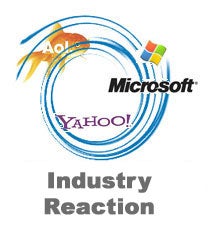 Yesterday, Yahoo!, Aol and Microsoft announced that they were going to sell each other’s “premium” non-guaranteed display inventory through Microsoft Exchange (supported by AppNexus) and Right Media Exchange. From the release, RTB will be a part of the mix: “By integrating one another’s real-time bidding (RTB) technologies to facilitate the availability of nonreserved inventory by early 2012, Yahoo!, Microsoft and AOL expect to have the opportunity to access each other’s non-reserved inventory to achieve the benefits of scale and efficiency.” Read more.
Yesterday, Yahoo!, Aol and Microsoft announced that they were going to sell each other’s “premium” non-guaranteed display inventory through Microsoft Exchange (supported by AppNexus) and Right Media Exchange. From the release, RTB will be a part of the mix: “By integrating one another’s real-time bidding (RTB) technologies to facilitate the availability of nonreserved inventory by early 2012, Yahoo!, Microsoft and AOL expect to have the opportunity to access each other’s non-reserved inventory to achieve the benefits of scale and efficiency.” Read more.
AdExchanger.com reached out to publisher-focused members of the ad ecosystem for their “take” on the announcement.
Click below or scroll down:
- Jim Spanfeller, CEO & Founder, Spanfeller Media Group
- David Soloff, CEO, Metamarkets
- Steve Shaw, President, Cox Digital Solutions
Jim Spanfeller, CEO & Founder, Spanfeller Media Group
“Surprised, and not, by this announcement. On the one hand, I get where the portals are working hard to answer the rise of social inventory and the growing involvement of Google in the display ad ecosystem. On the other, this seems like it might have an adverse effect to what is intended. Clearly, the world of available inventory in the digital ecosystem is getting stratified. As this happens true premium inventory (high quality environment above the fold placements) will be shown to be in high demand with limited supply. But against that very desirable backdrop, I would fear that by doing this, the portals will do to themselves what has been done to the greater digital content ecosystem over the last few years. Just as the general web is moving away from communization of high quality inventory, the portals seem to be charting a course to bundle their good placements (think “Yahoo! Finance,” for example) in with their not so good (think Mail).”
David Soloff, CEO, Metamarkets
“I don’t believe this is much more than a very public alliance of old line digital media and software companies in the last stages of being eclipsed by the Four Horsemen (Amazon, Apple, Google, Facebook). They know they must do something, anything, to stave off irrelevance. I just don’t see this particular arrangement being able to do that.
This really seems to be a co-marketing/co-selling arrangement whereby ‘bits and pieces’ of inventory on the networks are packaged up for manual fills. What is of most significance is what is unspoken — namely that these once mighty companies are now entirely on their back feet. They are very visibly and publicly operating on the defensive. This is ‘circling the wagons;’ my fear would be that these allies find nobody has brought sufficient ammunition to stave off the attack.
In parsing the press release and the conference call, there are three clear signs this is entirely about public unity and not at all about technological integration (which would be the single point of integration that could feasibly slingshot an initiative like this to the market lead):
Continued competition for inventory. Taken to a logical conclusion, this means the co-sold inventory is only that inventory with no market buyer at the network price. This more than anything else indicates this play will be an inventory rollup mechanism for fragmented, subscale chunks of inventory. It’s hard to imagine any of these players would take clearly identifiable premium tranches and bundle them up with another network’s product.No mechanism for establishing floor pricing — this means inventory will fall to the lowest supportable price. Remember, this inventory has already passed it’s shelf-life, or is too fragmented to command premium pricing, by the time it’s being packaged up. Without pricing analytics and floor mechanisms we will likely see ‘suicide pricing.’
These are entirely, 100% manual deals — not automated selling of premium inventory across networks. There don’t seem to be plans to route or leverage Microsoft of Yahoo ad exchange infrastructure, at least not in the near or mid-term. I’m really unclear as to why this would be the play — the truly bold move here would be to take all of that fragmented (but premium domain) inventory and route it through AppNexus.”
Steve Shaw, President, Cox Digital Solutions
“The online advertising industry is in a state of consolidation. This is happening not because the industry as it currently operates is not working, it is happening because as we look at the online ecosystem, we are seeing just how intertwined we all are and how much we can enhance efficiencies by developing partnership like the one announced yesterday between Yahoo!, Microsoft, and AOL.
Ultimately, we all want the same thing – to provide efficiencies and results for advertisers and make money for publishers. Everything that we do in this industry focuses on those two group. The industry is evolving so rapidly that companies just don’t have the time, resources, or IP to create every piece of technology to serve advertisers and publishers on their own, which is another reason why we are seeing these mergers and partnerships. By consolidating and partnering, publishers and advertisers benefit from the efficiencies of reach and the ability to deliver and target precise users across a broader set of sites.
Yahoo!, Microsoft, and AOL are all players in this industry serving a very specific market need – providing scale and technology. However, each advertiser and publisher has a unique set of objectives and as a result, there are different companies to fulfill those needs. We have scale but we also build direct relationships with our publisher partners. These partnerships enable us to deliver transparent, impactful advertising solutions (beyond just a banner) that connect advertisers with engaged, loyal users on vertical and local media sites and make money for our publishers. That said, we are thrilled to be part of an ecosystem that continues to work toward delivering efficiencies and solutions that help publishers and advertisers succeed.”
By John Ebbert
More AdExchanger “Industry Reactions”…
- Can It Be Done? Local, Direct, Automated Ads
- The Impact Of No More Third-Party Cookie Targeting In Firefox
- House Ads – What Are They Good For?
- What is "Premium"?
- When Is A Startup No Longer A Startup?
- Why Is Procurement Necessary?
- Agency CEOs: 2013 Planning Is About Mobile Integration
- Can You Build a Brand in Programmatic Media?
- How Do Native Advertising and Real-Time Bidding Meet?
- Why Target The Tablet?
- The Publisher Impact Of Facebook Exchange And Ad Network
- Agencies Upbeat on Tying Facebook to Cross-Channel Ads
- Are Advertisers Living the Dream of Unified Marketing and IT?
- What Next For Yahoo?
- What Counts as 'Scale' in Hyperlocal? Mobile Ad Players Weigh In
- Facebook Buys Instagram – What’s In It For Ads?
- Are Ad Servers Specifically For Publishers Or Advertisers Still Necessary?
- How Will The iPad 3 Impact Audience Buying Available Through The iPad?
- Will The Merger Of DDS And MediaBank Into Mediaocean Benefit Media Buying?
- Will SSPs and Ad Networks Sell Publisher Inventory Through DoubleClick Ad Exchange?
- The Industry 'Take' On SAS Acquiring aiMatch
- Industry Impressions Of Facebook Display Advertising
- What Are The Hurdles In Cross-Digital, Audience Buying?
- When Is A Mobile, Private Exchange Relevant To A Marketer's Needs?
- Your Ad Server, My Ad Server: Trends With Discrepancies Today
- The Opportunities Ahead For New Yahoo! CEO Scott Thompson – Industry Reaction
- Predictions 2012
- Industry Reaction: Adobe Acquires Efficient Frontier
- Yahoo! Requiring RMX Seats For DSP Advertisers
- Yahoo!, Aol And Microsoft Pool Their Premium, Non-Guaranteed Display Inventory
- Whats The Biggest Challenge With Platform Buying In Digital Today?
- Industry Reaction: Yahoo! Acquires interclick For $270 Million
- How Important Is -First Look- At Inventory?
- Where Does The Tablet Fit In The Marketer Media Plan?
- MediaBank-DDS Merger Industry Reaction: Questions Remain About MediaOcean
- Is An Online GRP Needed For Online Video Advertising?
- What Should Yahoo Do Next?
- What Solutions Are Still Needed For The Premium, Digital Publisher of Today?
- How Do Search Marketers Overcome The Creative Challenge In Graphical, Display Advertising?
- What Is The Difference Between A Social Display Impression And A Regular Display Impression?
- Is Audience Buying Possible In Mobile Advertising?
- What Are The Key Metrics For Brand Awareness Campaigns In An Automated Buying Environment?
- What Is The Biggest Challenge With The Demand-Side Platform Model?










